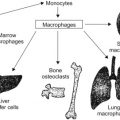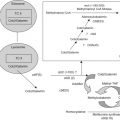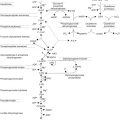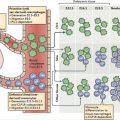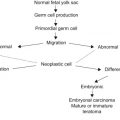Abstract
Renal tumors comprise roughly 6% of all childhood malignancies. Wilms’ tumor is the most common pediatric renal tumor. Less common renal tumors include clear cell sarcoma of the kidney, malignant rhabdoid tumor of the kidney, and renal cell carcinoma. Wilms’ tumor is known to be associated with multiple genetic disorders, including Beckwith–Wiedemann syndrome, Denys–Drash syndrome, and WAGR syndrome. Treatment for pediatric renal tumors is multimodal, and requires close collaboration between subspecialists with expertise in oncology, surgery, and radiation oncology.
Keywords
Wilms tumor, nephroblastoma, rhabdoid tumor, clear cell sarcoma, renal cell carcinoma, congenital mesoblastic nephroma, nephroblastomatosis
Wilms’ Tumor
Incidence
- •
Renal tumors comprise approximately 6% of all childhood cancers and nearly 10% of all malignancies among children aged 1–4 years.
- •
Wilms’ tumor (nephroblastoma) is the most common primary renal tumor of childhood and the sixth most common childhood malignancy in the United States.
- •
The male to female ratio 0.92:1.00 in unilateral Wilms’ and 0.6:1.00 in bilateral Wilms’ tumor.
- •
Wilms’ tumor, clear cell sarcoma of the kidney, and malignant rhabdoid tumor of the kidney occur predominantly in younger children and are rarely seen after 10 years of age. The majority of renal tumors occurring in adolescents and young adults are renal cell carcinomas (RCCs).
- •
Seventy-eight percent of children with Wilms’ tumor are diagnosed at 1–5 years of age, with a peak incidence occurring between 3 and 4 years of age. The median age of presentation is 44 months in unilateral disease and 32 months in bilateral disease.
- •
Wilms’ tumor is usually sporadic, but 1% of cases are familial.
Associated Congenital Anomalies
Congenital anomalies occur in 12–15% of cases. The most frequently diagnosed congenital anomalies are aniridia, genitourinary anomalies, and hemihypertrophy. Table 25.1 lists the incidence of congenital anomalies in patients with Wilms’ tumor.
| Anomaly | Incidence (%) |
|---|---|
| Genitourinary anomalies: horseshoe kidney, dysplasia of kidney, cystic disease of kidney, hypospadias, cryptorchidism, duplication of collecting system | 4.4 |
| Congenital aniridia | 1.1 |
| Congenital hemihypertrophy | 2.9 |
| Musculoskeletal anomalies: clubfoot, rib fusion, distal phocomelia, hip dislocation | 2.9 |
| Hamartomas: hemangiomas, “birthmarks,” multiple nevi, café-au-lait spots | 7.9 |
The three best characterized syndromes associated with Wilms’ tumor include:
- •
WAGR syndrome.
- •
Denys–Drash syndrome.
- •
Beckwith–Wiedemann syndrome.
Other syndromes with an estimated Wilms’ tumor risk of at least 5% are listed in Table 25.2 .
| Syndrome | Chromosome locus | Implicated gene(s) | Phenotype | Estimated Wilms’ tumor risk% |
|---|---|---|---|---|
| WAGR | 11p13 | WT1 | Aniridia, genitourinary anomalies, delayed-onset renal failure | 30 |
| Denys–Drash | 11p13 | WT1 | Ambiguous genitalia, diffuse mesangial sclerosis | >90 |
| Frasier | 11p13 | WT1 | Ambiguous genitalia, streak gonads, focal segmental glomerulosclerosis | 8 |
| Beckwith–Wiedemann Isolated hemihypertrophy | 11p15 | IGF2 , H19, KCNQ1 ( KvLQT1 ), KCNQ1OT1 (LIT1) , or CDKN1C ( p57 KIP2 ) | Organomegaly, large birth weight, macroglossia, omphalocele, hemihypertrophy, ear pits and creases, neonatal hypoglycemia | 5 |
| Perlman | 2q37 | DIS3L2 | Prenatal overgrowth, facial dysmorphism, developmental delay, cryptorchidism, renal dysplasia | 33 |
| Mosaic variegated aneuploidy | 15q15 | BUB1B | Microcephaly, growth retardation, developmental delay, cataracts, heart defects | 25 |
| Fanconi anemia D1 | 13q12 | BRCA2 | Short stature, radial ray defects, bone marrow failure | 20 |
| Simpson–Golabi–Behmel | Xq26 | GPC3 | Overgrowth, course facial features | 10 |
WAGR Syndrome
- •
The syndrome consists of Wilms’ tumor, aniridia, genitourinary malformations, and mental retardation, but other associated anomalies are seen.
- •
A chromosomal deletion has been consistently found in the short arm of chromosome 11 (11p13 deletion). This area encompasses both the WT1 and PAX6 genes; WT1 is implicated in Wilms’ tumor and PAX6 is implicated in aniridia.
- •
Aniridia is present in 1.2% of children with Wilms’ tumor.
- •
A child with sporadic aniridia has a 5% chance of developing Wilms’ tumor; most cases of sporadic aniridia have PAX6 mutations/deletions but not WT1 deletions. A child with WT1 deletion has a 30–40% risk of Wilms’ tumor.
- •
WAGR syndrome is associated with focal segmental glomerular sclerosis and renal failure in 30–40% of individuals 20 years following Wilms’ tumor diagnosis.
Denys–Drash Syndrome
- •
The syndrome consists of Wilms’ tumor, early renal failure with mesangial sclerosis, and pseudohermaphroditism.
- •
Associated with point mutations of the WT1 gene.
- •
Associated with 90% risk of Wilms’ tumor.
Beckwith–Wiedemann Syndrome
- 1.
This syndrome consists of
- •
Hyperplastic fetal visceromegaly involving the kidney, adrenal cortex, pancreas, gonads, and liver, hemihypertrophy, macroglossia, abdominal wall defects (omphalocele, umbilical hernia, diastasis recti), ear pits or creases, microcephaly, mental retardation, hypoglycemia, and postnatal somatic gigantism.
- •
Predisposition to embryonal tumors (Wilms’ tumor, hepatoblastoma, neuroblastoma, and rhabdomyosarcoma) and adrenocortical carcinoma. Risk of Wilms’ tumor is approximately 5%.
- •
- 2.
The Beckwith–Wiedemann locus at chromosome 11p15.5 contains a cluster of imprinted genes ( IGF2 , H19 , CDKN1C , KCNQ10T1 , and KCNQ1 ). Various genetic and epigenetic changes can lead to the phenotypic features of the syndrome. This locus is often referred to as WT2.
Screening of Children with WAGR, Denys–Drash, and Beckwith–Wiedemann Syndromes
Among individuals with Beckwith–Wiedemann syndrome and Wilms’ tumor, 93% develop the tumor by 8 years of age. Therefore, children with Beckwith–Wiedemann syndrome should have an abdominal ultrasound every 3 months until 8 years of age to evaluate for abdominal malignancies. Serum α-fetoprotein level should be tested during infancy and early childhood because of the association with hepatoblastoma. 11p15 mutation and methylation analysis should be considered because new data indicate that certain Beckwith–Wiedemann epigenetic changes are associated with a higher risk of tumor development than others. Among individuals with WAGR syndrome and Wilms’ tumor, 90% develop the tumor by age 4 and 98% by age 7 years. Based on this information, children with WAGR and Denys–Drash syndromes should have screening abdominal ultrasounds every 3 months until 5 years of age, but screening may be extended if Wilms’ tumor precursor lesions (nephrogenic rests) are identified. Children with sporadic aniridia should be referred for FISH (fluorescence in situ hybridization) of the WT1 gene because if WT1 is not deleted, the risk of Wilms’ tumor is similar to the population risk.
Signs and Symptoms
- •
Initial signs and symptoms, in order of frequency, are listed in Table 25.3 .
Table 25.3
Initial Signs and Symptoms of Wilms’ Tumor in Order of Frequency
Sign/symptom
Frequency (%)
Palpable mass in abdomen
60
Hypertension
25
Hematuria
15
Obstipation
4
Weight loss
4
Urinary tract infection
3
Diarrhea
3
Previous trauma
3
Other signs/symptoms: nausea, vomiting, abdominal pain, inguinal hernia, cardiac insufficiency a , acute surgical abdomen, pleural effusion, polycythemia
8
a Due to propagation of tumor clot from inferior vena cava into right atrium.
- •
Abdominal mass is the most common presenting symptom and sign. Occasionally, there is abdominal pain, especially when hemorrhage occurs in the tumor following trauma.
- •
Hematuria is not common but is more often seen microscopically than on gross examination.
- •
Hypertension is seen in approximately 25% of patients due to elaboration of renin by tumor cells or, less commonly, due to distortion or compression of renal vasculature.
- •
Polycythemia is occasionally present. Erythropoietin levels are usually increased but can also be normal. Polycythemia is usually associated with males, older age, and low clinical stage. All children with unexplained polycythemia should be investigated for Wilms’ tumor.
- •
Bleeding diathesis can occur due to the presence of acquired von Willebrand disease (reduced von Willebrand factor antigen level, prolonged bleeding time, decreased factor VIII and factor VIII ristocetin cofactor activity). The frequency of this complication is unknown.
Diagnostic Studies
Table 25.4 lists the standard clinical, laboratory, and radiographic investigations required to evaluate a patient with a suspected renal tumor. Since the most common initial surgical approach is nephrectomy, the following information is required prior to surgery:
- •
Presence/absence of a functioning kidney on the contralateral side.
- •
Presence/absence of lung or liver metastases.
- •
Presence/absence of bone or brain metastases if indicated by history or physical examination.
- •
Presence/absence of tumor thrombus in the renal vein or inferior vena cava (IVC).
|
Staging System
Table 25.5 describes the current staging system for renal tumors utilized by the Renal Tumors Committee of the Children’s Oncology Group (COG).
| STAGE I |
|
| STAGE II |
|
| STAGE III |
|
| STAGE IV |
|
| STAGE V |
|
Pathology
Wilms’ tumor is derived from primitive metanephric blastema and is characterized by histopathologic diversity. The classic Wilms’ tumor is composed of persistent blastema, dysplastic tubules (epithelial), and supporting mesenchyme or stroma. The coexistence of epithelial, blastemal, and stromal cells has led to the term triphasic to characterize the classic Wilms’ tumor. Each of the cell types may exhibit a spectrum of differentiation, generally replicating various stages of renal embryogenesis. The proportion of each cell type may also vary significantly from tumor to tumor. Some Wilms’ tumors may be biphasic or even monomorphous in appearance. The absence of anaplastic features identifies Wilms’ tumors as having favorable histology (FH). Clear cell sarcoma of the kidney, rhabdoid tumor of the kidney and RCCs have unique histologies and are not Wilms’ tumor variants.
Anaplastic Wilms’ Tumor
Histologic Findings
Anaplastic histology is identified by the presence of cells with nuclear enlargement, nuclear atypia, and irregular mitotic figures. Focal anaplasia is distinguished from diffuse anaplasia by the distribution of anaplastic elements. Anaplasia well-contained within a single region of the tumor is considered focal anaplasia and anaplasia found in multiple regions of the tumor or outside the renal parenchyma is considered diffuse anaplasia.
FH, as the name implies, is associated with the best prognosis, followed by focal anaplasia, followed by diffuse anaplasia, which has significantly worse prognosis.
A diagnosis of diffuse anaplasia is made if the following characteristics are present:
- •
Anaplasia in any extrarenal site, including vessels of the renal sinus, extracapsular infiltrates, or nodal or distant metastases.
- •
Anaplasia in a random biopsy specimen.
- •
Anaplasia unequivocally expressed in one region of the tumor, but with extreme nuclear pleomorphism approaching the criteria of anaplasia (extreme nuclear unrest) elsewhere in the lesion.
- •
Anaplasia in more than one tumor slide, unless (i) it is known that every slide showing anaplasia came from the same focused region of the tumor or (ii) anaplastic foci on the various slides are minute and surrounded on all sides by non-anaplastic tumor.
Loss of Heterozygosity as a Prognostic Factor for Wilms’ Tumor
Loss of heterozygosity (LOH) for polymorphic DNA markers at both chromosomes 1p and 16q occurs in approximately 5% of FH Wilms’ tumor cells, and has been shown to be associated with inferior relapse-free survival (RFS) and overall survival (OS) in patients with FH Wilms’ tumor. Table 25.6 summarizes the prognostic significance of LOH for 1p and 16q in the context of therapy used on NWTS-5. Although LOH 1p/16q has been used for risk stratification and therapy determination in the most recent COG studies, it is not known at this time whether subsequent alteration of upfront therapy will improve the inferior RFS and OS conferred by LOH of 1p and 16q.
| Stage | LOH Status | 4-year RFS (%) | RR | P | 4-year OS (%) | RR | P |
|---|---|---|---|---|---|---|---|
| I or II | Neither | 91.2 | 98.4 | ||||
| I or II | Both | 74.9 | 2.88 | 0.001 | 90.5 | 4.25 | 0.01 |
| III or IV | Neither | 83.0 | 91.9 | ||||
| III or IV | Both | 65.9 | 2.41 | 0.01 | 77.5 | 2.66 | 0.04 |
Stay updated, free articles. Join our Telegram channel

Full access? Get Clinical Tree



